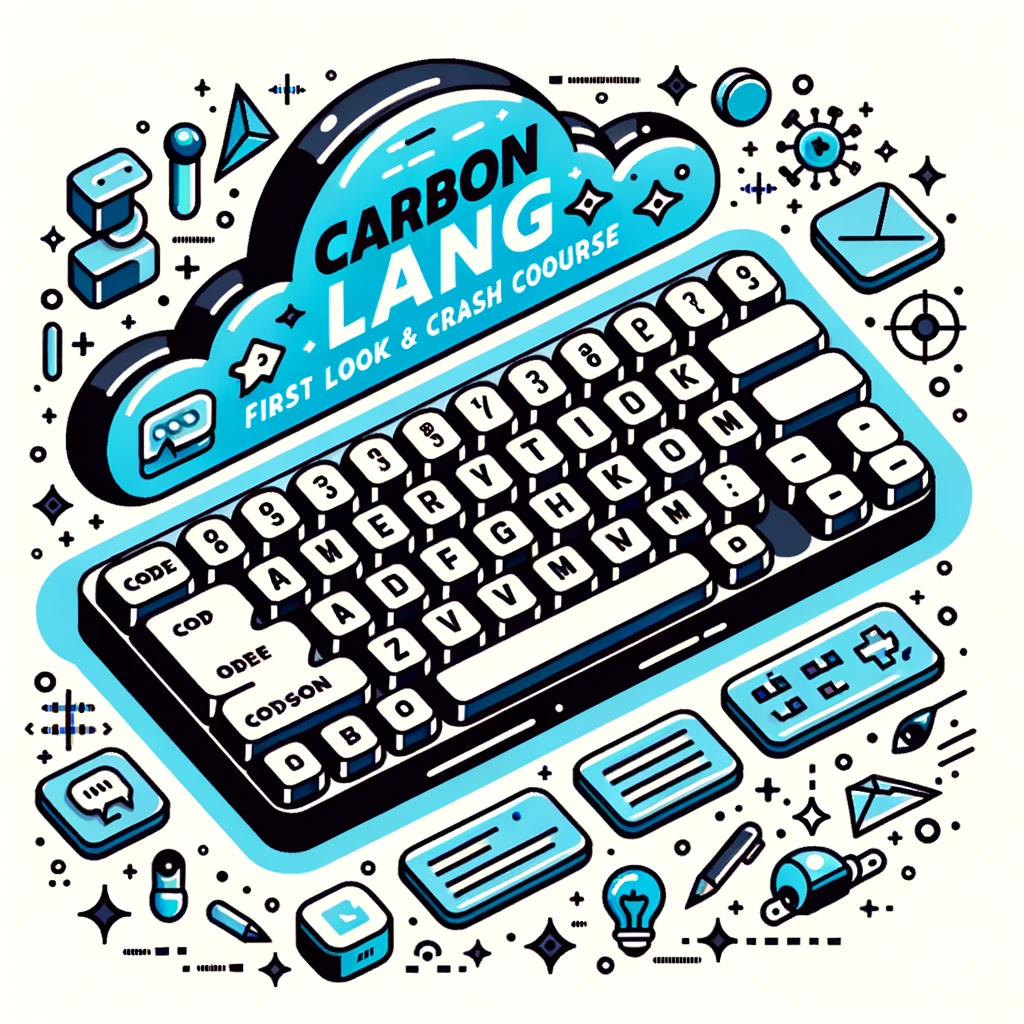Hey there! Have you heard about Carbon, Google’s new C++ successor? It’s an experimental language that aims to provide interoperability with existing C++ code. In this video by Traversy Media, you’ll get a crash course on Carbon and learn about its basic syntax, including variables, data types, arrays, tuples, classes, generics, and more. The video also provides timestamps for different topics discussed and offers additional resources for further learning. So, if you’re interested in exploring a new programming language and expanding your knowledge, this video is a great place to start!
Understanding Google’s New Project: Carbon Lang
The birth and purpose of Carbon lang
Carbon lang is Google’s experimental successor to C++. It aims to provide interoperability with existing C++ code while addressing the limitations and challenges faced by C++. The goal is to support performance-critical software, provide a modern generic system, ensure memory safety, and offer fast and scalable development. Carbon lang is designed to be easy to read, understand, and write, with a consistent and simple syntax.
Interoperability with existing C++ code
One of the key features of Carbon lang is its ability to interoperate with existing C++ code. This means that developers can write Carbon code that can call C++ functions and libraries and vice versa. This allows for the gradual migration of large C++ codebases to Carbon, without the need for a complete rewrite. Carbon’s interoperability with C++ extends to features such as inheritance and templates.
Goals of Carbon Lang
Carbon lang has several goals that it aims to achieve. These goals include supporting performance-critical software, providing a modern generic system, ensuring memory safety, and offering fast and scalable development. By addressing these goals, Carbon lang aims to overcome the limitations and challenges of C++ and provide a more efficient and secure programming language.
Key Language Features of Carbon
Introduction to packages, functions, print command
Carbon lang introduces the concept of packages, which are containers for organizing and grouping related code. Packages provide a way to organize code into logical units and avoid naming conflicts. Functions are a fundamental building block of Carbon lang and are used to encapsulate logic and perform specific tasks. The print command is used to output text to the console and is commonly used for debugging and displaying information to the user.
Explicit typing of variables
In Carbon lang, variables are explicitly typed, meaning that the type of a variable is declared at the time of its creation. This allows for better code readability and helps prevent type-related bugs. By explicitly declaring the type of variables, developers can ensure that their code is easier to understand and maintain.
Conventions for naming entities
Carbon lang follows specific naming conventions for entities such as packages, functions, and variables. In Carbon, upper camel case is used for naming packages and functions, while lower snake case is used for variable names. Following these conventions helps improve the clarity and readability of code and makes it easier for other developers to understand and work with the codebase.
Exploring Carbon’s Primitive Data Types
Understanding booleans, integers, and floating point numbers in Carbon
Carbon lang supports several primitive data types, including booleans, integers, and floating-point numbers. Booleans represent true/false values and are used for logical operations. Integers are used to represent whole numbers and can be signed or unsigned. Floating-point numbers are used to represent real numbers with fractional parts and allow for more precise calculations.
Usage of strings and multi-line strings
Strings are used to represent text data in Carbon lang. Strings are enclosed in double quotes and can contain alphanumeric characters as well as special characters. Carbon lang also supports multi-line strings, which are enclosed in triple quotes. Multi-line strings allow for formatting and line breaks within the string.
Var and Let: How to create variables and constants in Carbon
In Carbon lang, variables can be created using the var keyword. The type of the variable is inferred from the value assigned to it. Constants, on the other hand, can be created using the let keyword. Constants cannot be reassigned once a value is assigned to them. Using variables and constants in Carbon lang allows for the storage and manipulation of data throughout the program.
Advanced Variable Concepts in Carbon
Introduction to global variables and their scope
Carbon lang allows for the use of global variables, which can be accessed and modified from anywhere in the program. Global variables have a scope that extends throughout the entire program. This means that they can be accessed and modified from within functions, classes, and other blocks of code.
Auto keyword: Dynamically determining variable types
The auto keyword in Carbon lang allows the compiler to dynamically determine the type of a variable based on the value assigned to it. This reduces the need for explicit type declarations and provides flexibility in writing code. The auto keyword is particularly useful when the type of a variable is complex or when it is subject to change.
Utilizing the compiler explorer to execute Carbon code
Carbon lang provides a compiler explorer tool that allows developers to execute Carbon code and see the generated assembly code. This tool helps in understanding how Carbon code is compiled and optimized by the compiler. By using the compiler explorer, developers can gain insights into the inner workings of Carbon lang and make informed decisions about code optimization.
Function Arguments and Scope in Carbon
What is function scope and its usage?
Function scope refers to the visibility and accessibility of variables and other entities within a function. In Carbon lang, variables declared within a function are only accessible within that function’s scope. This helps in encapsulating and organizing code, preventing naming conflicts, and improving code readability and maintainability.
Understanding function arguments with an example
Function arguments are values that are passed to a function when it is called. In Carbon lang, function arguments are declared within the parentheses of the function declaration. These arguments can be used within the function body to perform calculations or manipulate data. Function arguments allow for code reuse and flexibility by making functions adaptable to different inputs.
The concept of global variables in Carbon lang
Carbon lang allows for the use of global variables, which are variables that can be accessed and modified from anywhere in the program. Global variables have a scope that extends throughout the entire program. They can be useful for storing and accessing data that needs to be shared across different functions or blocks of code.
Working with Arrays, Tuples and Structs in Carbon
General overview of arrays, tuples, structs
Arrays, tuples, and structs are data structures used in Carbon lang to store multiple values. Arrays are collections of values of the same type and have a specific size. Tuples are similar to arrays but do not have a fixed size. They can hold values of different types and can be used to represent multiple values grouped together. Structs, also known as structures, are similar to objects in other programming languages and allow for the creation of custom data types with properties and methods.
Way to store multiple values: Arrays vs Tuples
Arrays and tuples offer different ways to store multiple values in Carbon lang. Arrays are useful when a fixed number of values of the same type needs to be stored. Tuples, on the other hand, can hold values of different types and do not have a fixed size. Tuples provide flexibility and can be used when the exact number of values or their types are not known in advance.
How to convert tuples to arrays?
In Carbon lang, tuples can be converted to arrays by using the array constructor array(). The array() constructor takes the tuple as its argument and returns an array with the values from the tuple. This conversion allows for the manipulation and use of tuple values as if they were array elements.
Introducing Classes, Objects and Methods in Carbon Language
Understanding key-value pairs in Structs
Structs in Carbon lang allow for the creation of custom data types with key-value pairs. Each key-value pair represents a property of the struct. The values can be of any valid Carbon data type. Structs provide a way to organize related data and encapsulate behavior within the same structure.
Insight into the properties and methods of classes
Classes in Carbon lang are used to create objects that encapsulate data and behavior. A class can have properties, which represent the state of the object, and methods, which define the behavior and actions that the object can perform. Properties and methods are defined within the class definition and accessed using the dot notation.
Usage of ‘me’ variable and class-specific functions in Carbon
The me variable in Carbon lang is a special variable that refers to the current instance of a class. It allows class methods to access the properties and methods of the current instance. This provides a way to refer to and modify the state of an object from within its own methods. Class-specific functions, on the other hand, are functions that belong to a specific class and can only be called on instances of that class.
Understanding Pointers: Syntax and Functionality
Use of ampersand operator to get the address
In Carbon lang, the ampersand operator (&) is used to get the memory address of a variable. The address represents the location of the variable in the computer’s memory. Pointers are variables that store memory addresses, and they can be used to indirectly access and modify the value stored at that memory location.
Setting p to address of x and updating its value
To use pointers in Carbon lang, a variable is declared as a pointer by appending an asterisk (*) to the variable type. For example, int* p; declares p as a pointer to an integer. To assign the address of a variable to a pointer, the ampersand operator is used. For example, p = &x; assigns the address of variable x to pointer p. The value stored at the memory location can be accessed and modified using the pointer.
Creating q as another variable and setting it to the address of *p
In Carbon lang, variables can also be declared as pointers to other pointers. This allows for the creation of more complex memory structures. For example, int** q; declares q as a pointer to a pointer to an integer. The address of a pointer can be assigned to another pointer, allowing for multi-level memory indirection.
Using Conditionals and Loops in Carbon
The process of using If-else statements
Conditional statements are used in Carbon lang to make decisions based on certain conditions. The if-else statement is a common conditional statement that allows for branching based on a condition. In Carbon, the condition is enclosed within parentheses, and the code block to be executed is enclosed within curly braces. The else keyword is used to define an alternative block of code to be executed if the condition is false.
Match statement as a replacement for switch
The match statement in Carbon lang is a replacement for the traditional switch statement found in many programming languages. The match statement allows for pattern matching against multiple cases. Each case represents a potential value or pattern that the input can match. The match statement provides a more concise and expressive way of handling multiple cases compared to nested if-else statements.
Decrementing variable value using a while loop in Carbon
Loops in Carbon lang are used to repeat a block of code multiple times. The while loop is a type of loop that continues execution as long as a specified condition is true. Within the loop, the condition is checked, and if it evaluates to true, the loop body is executed. The loop continues until the condition evaluates to false. The while loop can be used to decrement a variable value and perform a specific action until a certain condition is met.
Conclusion
Key takeaways from the crash course
In this crash course on Carbon lang, we covered several key aspects of the language. We explored the birth and purpose of Carbon lang, its interoperability with C++ code, and its goals. We delved into the key language features of Carbon, including packages, functions, and explicit typing of variables. We also explored Carbon’s primitive data types, advanced variable concepts, function arguments and scope, arrays, tuples, structs, classes, objects, methods, pointers, conditionals, and loops.
Potential future developments and enhancements in Carbon
As Carbon lang is an experimental language, there is a possibility for future developments and enhancements. These could include improvements to the syntax, performance optimizations, and additional language features. The Carbon community and the developers behind the language will play a vital role in shaping its future and making it more robust and widely adopted.
Further resources and recommendations for learning Carbon
To continue learning Carbon lang, there are various resources available. Official documentation, tutorials, and example code can provide deeper insights into the language and its features. Additionally, participating in the Carbon community, joining forums, and engaging in discussions can help in gaining practical knowledge and staying up to date with the latest developments. It is recommended to explore the Carbon Main Repo and Gist File provided in the video for hands-on experience with the language.










